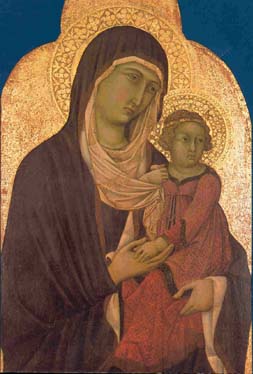
Annual Bulletin 5, 1981-1982
Home
Français
Introduction
History
Annual Index
Author &
Subject
Credits
Contact



Ugolino di
Nerio: Saint Anne and the Virgin
by Laurence B. Kanter
Article en français
Pages 1 | 2 |
3 | 4 |
5 | 6 |
7
Duccio di Buoninsegna (doc. 1278-1315) was certainly the most influential painter
of the early Renaissance in Siena. But among his numerous close followers,
amounting to almost an entire generation of artists, only two are known
today by name: Segna di Bonaventura and Ugolino di Nerio. Ugolino is mentioned
as a painter in three documents, of 1315, 1325, and 1327. (1) Though none
of these refers to an identifiable work of art, Vasari wrote that Ugolino
painted the high altarpiece in the church of Santa Croce in Florence, and
the artist's signature, Ugolino da Siena, was still recorded beneath one
of the panels of that altarpiece in 1837. (2) These panels are now scattered
among museums in Berlin (fig. 6), London, New York, Philadelphia, and Los
Angeles. They provide the foundation for an understanding of Ugolino's
style, and based on resemblances to them dozens of other altarpieces, altarpiece
fragments, and independent devotional works have also been attributed to
him.
The National Gallery of Canada's recently
acquired Saint Anne and the Virgin (3) is a beautiful and important
example of Ugolino's mature style (fig. 1 and cover). Saint Anne is shown
dressed in a fur-lined blue mantle. She supports her infant daughter in
the crook of her left arm and gazes out of the picture to the (viewer's)
right. The young Virgin, in a long skirt of bright orange-red and a pink
vest with pale blue highlights, both sumptuously embroidered in gold, follows
her mother's gaze. She pulls at the veil around Saint Anne's throat and
plays idly with her right hand. A gold crown binds the child's long blonde
curls. Both figures have elaborately decorated haloes stamped into the
gold ground of the panel.
In 1953, the picture was transferred from
its original poplar wood support to masonite. It was cleaned at that time,
and just prior to its acquisition by the National Gallery of Canada, the
gold ground was freed of modern overpaint. (4) In its present condition
the ground is somewhat rubbed, exposing the red bole underneath, while
the gold of the haloes is almost perfectly preserved. At some point the
panel was cut across the top and slightly along the bottom and left side,
truncating the original trefoil shape of the picture field and squaring
the panel's arched profile. Notwithstanding these alterations, the painting
is preserved in a remarkably pure state. Damages to the paint surface,
other than losses along the bottom edge, are minimal and insignificant.
The subject of the Ottawa panel is unusual
and deserves some comment. At a glance it could easily be taken for a more
traditional representation of the Madonna and Child, but for the infant's
longer hair and feminine attire and the lack of certain attributes mandatory
in images of the Infant Christ and His Mother. The Blessed Virgin, when
shown as the mother of Christ, always bears a star on her shoulder or on
her cowl. The mother in the Ottawa painting, though clad in the Virgin's
traditional colour, blue, displays no such star. The Christ Child in early
Italian pictures is invariably portrayed with a cruciform nimbus. The child's
halo in the Ottawa painting has no such distinguishing characteristic.
Neither figure in the Ottawa painting can be positively identified on
the basis of a specific attribute, but most early representations of
Saint Anne and the Virgin are vague. They have in common only that they
all borrow their compositions from the traditional Madonna and Child
type, and that they are distinguished from the latter only by the gender
of the child.
Though the cult of Saint Anne had been introduced
in the West as early as the eighth century, (5) her iconography was not
stabilized until the late fourteenth. From that time, representations of Saint Anne
became popular throughout Europe in the form of the Anna Selbdritt or Sant'Anna
Meterza: an abbreviated genealogy of Christ in which
an elderly Saint Anne supports her (mature) daughter on her knees, who
in turn holds her own infant Son. Masaccio's and Leonardo's are merely
the most famous among the numerous examples of this type of image. Later,
and particularly in the Baroque period, the domestic scene of Saint Anne
teaching her young daughter to read replaced the Anna Selbdritt in
popularity. But at the beginning of the fourteenth century Ugolino would
have bad very few prototypes available for his imagery, which must explain
the lack of explicit attributes identifying his figures. The most famous
earlier example of a two-figure composition of the Virgin with Saint Anne
is the sculptural group decorating the trumeau of the North Portal at Chartres
Cathedral, (6) and the stained glass in the window above it. In Italy the
image seems primarily to have been confined to byzantinizing contexts. (7)
One significant exception is the late thirteenth-century dossal by Rainieri
di Ugolino (fig. 2) in the Museo Nazionale di San Matteo at Pisa. In this
painting Saint Anne is represented enthroned with her infant daughter
on her knee and two adoring angels behind. As in the Ottawa painting, the
mother bas no identifying stars and the child, uncrowned but obviously
female, does not have a cruciform halo (the mother's halo was improperly
repainted by an untutored restorer). Final proof of their identities is
offered by the inscription against the gold ground over the elder figure's
right shoulder: SA ANNA.
Next Page | Cult of Saint Anne
1 |
2 | 3 | 4 |
5 |
6 | 7
Annual Index | Author & Subject | Credits | Contact
This digital collection
was produced under contract to Canada's Digital Collections program,
Industry Canada.
"Digital
Collections Program, Copyright
© National Gallery of
Canada 2001"